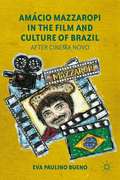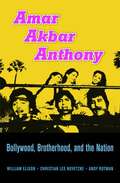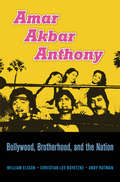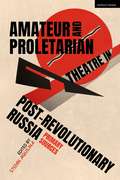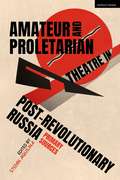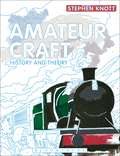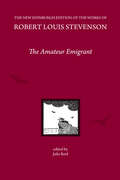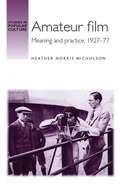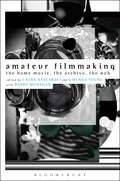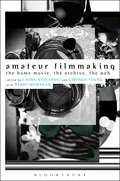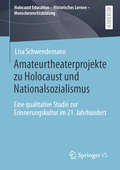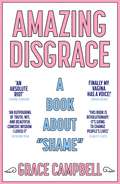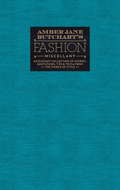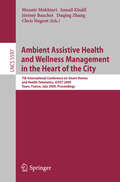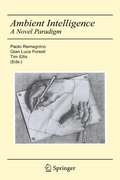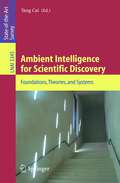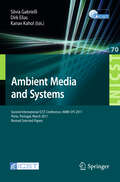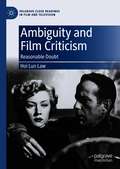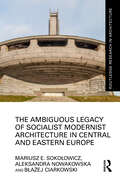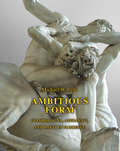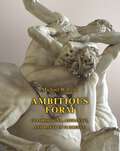- Table View
- List View
Always Smiling: The World According to Toff
by Georgia ToffoloFor fans of Made in Chelsea, I'm a Celeb and Celebs Go Dating, ALWAYS SMILING is the first book from the nation's favourite reality TV star Toff!Everyone loves Toff and she has come a long way since bursting onto our screens on E4's Made in Chelsea in 2014. As the runaway winner of I'm a Celebrity Get Me Out of Here 2017, Toff surprised us all, not least herself, with her positive, happy-go-lucky attitude and kindness to others, no matter what challenge came her way in the jungle. In ALWAYS SMILING, Toff is here to share her experiences, some funny, some sad, some that make her cringe with embarrassment. So whether it is friendships, family dramas, heartbreak and relationships, or how she coped with living her life in front of millions of viewers of Made in Chelsea, Toff reveals how she has learnt to keep a smile on her face, whatever life throws at her. Told with her trademark honesty, humour and endless sense of fun, ALWAYS SMILING is a must-have for any fan.
Amácio Mazzaropi in the Film and Culture of Brazil: After Cinema Novo
by E. BuenoAmácio Mazzaropi's work is a unique instance in Brazilian culture - as an artist not connected with the subsidized film industry, he developed a singular voice and represents a segment of the population usually either ignored or viewed with contempt by the established, experimental filmmakers.
Amar Akbar Anthony: Bollywood, Brotherhood, and the Nation
by William ElisonThe 1977 blockbuster Amar Akbar Anthony about the heroics of three Bombay brothers separated in childhood became a classic of Hindi cinema and a touchstone of Indian popular culture. Beyond its comedy and camp is a potent vision of social harmony, but one that invites critique, as the authors show.
Amar Akbar Anthony: Bollywood, Brotherhood, and the Nation
by William ElisonThe 1977 blockbuster Amar Akbar Anthony about the heroics of three Bombay brothers separated in childhood became a classic of Hindi cinema and a touchstone of Indian popular culture. Beyond its comedy and camp is a potent vision of social harmony, but one that invites critique, as the authors show.
Amateur and Proletarian Theatre in Post-Revolutionary Russia: Primary Sources
by Stefan AquilinaThis is the first collection of primary sources that addresses the amateur theatre produced by the workers in the first decade after the Russian Revolution. Newly translated from the Russian, the essays capture both theoretical articulations on the scene – by luminaries such as Alexander Bogdanov, Platon Kerzhentsev, Valerian Pletnev, Alexander Mgebrov and Valentin Smyshliaev – and the more fleeting descriptions and first-hand accounts of the productions staged, accounts and voices which are typically harder to capture. The essays tell a story of unabashed optimism in the creativity of the working classes. They speak of the use of theatre to carve a public and political role in the construction of a new world. The sources, however, also exhibit the flipside of the scene, or the sombre difficulties faced by the amateur actors and the incessant calls to raise standards through professional help. The narrative developed is that of an amateur theatre which began as an autonomous and heterogeneous activity but which by the mid-to-late 1920s was transformed into a regulated practice and a space for cultural programming. The collection makes an important contribution to our understanding of modern theatre: scholarship conventionally tackles the canonical names from the professional world but gives little attention to the more down-to-earth forms of performance taking place in factories, clubs and amateur circles. An introductory essay also highlights the range and significance of the collection and draws links between the essays.
Amateur and Proletarian Theatre in Post-Revolutionary Russia: Primary Sources
This is the first collection of primary sources that addresses the amateur theatre produced by the workers in the first decade after the Russian Revolution. Newly translated from the Russian, the essays capture both theoretical articulations on the scene – by luminaries such as Alexander Bogdanov, Platon Kerzhentsev, Valerian Pletnev, Alexander Mgebrov and Valentin Smyshliaev – and the more fleeting descriptions and first-hand accounts of the productions staged, accounts and voices which are typically harder to capture. The essays tell a story of unabashed optimism in the creativity of the working classes. They speak of the use of theatre to carve a public and political role in the construction of a new world. The sources, however, also exhibit the flipside of the scene, or the sombre difficulties faced by the amateur actors and the incessant calls to raise standards through professional help. The narrative developed is that of an amateur theatre which began as an autonomous and heterogeneous activity but which by the mid-to-late 1920s was transformed into a regulated practice and a space for cultural programming. The collection makes an important contribution to our understanding of modern theatre: scholarship conventionally tackles the canonical names from the professional world but gives little attention to the more down-to-earth forms of performance taking place in factories, clubs and amateur circles. An introductory essay also highlights the range and significance of the collection and draws links between the essays.
Amateur Craft: History and Theory
by Stephen KnottAmateur Craft provides an illuminating and historically-grounded account of amateur craft in the modern era, from 19th century Sunday painters and amateur carpenters to present day railway modellers and yarnbombers. Stephen Knott's fascinating study explores the curious and unexpected attributes of things made outside standardised models of mass production, arguing that amateur craft practice is 'differential' – a temporary moment of control over work that both departs from and informs our productive engagement with the world.Knott's discussion of the theoretical aspects of amateur craft practice is substantiated by historical case studies that cluster around the period 1850–1950. Looking back to the emergence of the modern amateur, he makes reference to contemporary art and design practice that harnesses or exploits amateur conditions of making. From Andy Warhol to Simon Starling, such artistic interest elucidates the mercurial qualities of amateur craft.Invaluable for students and researchers in art and design, contemporary craft, material culture and social history, Amateur Craft counters both the marginalisation and the glorification of amateur craft practice. It is richly illustrated with 41 images, 14 in colour, including 19th century ephemera and works of contemporary art.
Amateur Craft: History and Theory
by Stephen KnottAmateur Craft provides an illuminating and historically-grounded account of amateur craft in the modern era, from 19th century Sunday painters and amateur carpenters to present day railway modellers and yarnbombers. Stephen Knott's fascinating study explores the curious and unexpected attributes of things made outside standardised models of mass production, arguing that amateur craft practice is 'differential' – a temporary moment of control over work that both departs from and informs our productive engagement with the world.Knott's discussion of the theoretical aspects of amateur craft practice is substantiated by historical case studies that cluster around the period 1850–1950. Looking back to the emergence of the modern amateur, he makes reference to contemporary art and design practice that harnesses or exploits amateur conditions of making. From Andy Warhol to Simon Starling, such artistic interest elucidates the mercurial qualities of amateur craft.Invaluable for students and researchers in art and design, contemporary craft, material culture and social history, Amateur Craft counters both the marginalisation and the glorification of amateur craft practice. It is richly illustrated with 41 images, 14 in colour, including 19th century ephemera and works of contemporary art.
The Amateur Emigrant, by Robert Louis Stevenson (The\new Edinburgh Edition Of The Collected Works Of Robert Lewis Stevenson Ser.)
by R. L. StevensonThe Amateur Emigrant, an autobiographical account of Stevenson’s voyage from Scotland to California in 1879, is a rich and provocative work of late-Victorian travel writing and cultural criticism. It describes vividly how Stevenson mixed with ‘steerage’ passengers aboard an Atlantic steamship and experienced the indignities of a transcontinental emigrant train. The Amateur Emigrant engages critically with Victorian ideas about class, race, and gender, and makes an important contribution to the literature of emigration. Stevenson’s middle-class family and friends found the work so transgressive that it was withdrawn from publication at proof stage. It was published in bowdlerized form in 1895 and since then has rarely been available in the form in which Stevenson composed it.
Amateur film: Meaning and practice c. 1927–77 (Studies in Popular Culture)
by Heather NicholsonAmateur film: Meaning and practice 1927–77 plunges readers into the world of home movies making and reveals that behind popular perceptions of clichéd family scenes shakily shot at home or by the sea, there is much more to discover. Exploring who, how, where, when and why amateur enthusiasts made and shared their films provides fascinating insights into an often misunderstood aspect of national visual history. This study of how non-professional filmmakers responded to the new possibilities of moving image places decades of cine use into a history of changing visual technologies that span from Edwardian visual toys to mobile phones. Using northern cine club records, interviews and amateur films, the author reveals how film-making practices ranged from family footage to highly crafted edited productions about local life and distant places made by enthusiasts who sought to ‘educate, inspire and entertain’ armchair audiences during the early decades of British television.
Amateur Filmmaking: The Home Movie, the Archive, the Web
by Laura Rascaroli Gwenda Young Barry MonahanWith the advent of digital filmmaking and critical recognition of the relevance of self expression, first-person narratives, and personal practices of memorialization, interest in the amateur moving image has never been stronger. Bringing together key scholars in the field, and revealing the rich variety of amateur filmmaking-from home movies of Imperial India and film diaries of life in contemporary China, to the work of leading auteurs such as Joseph Morder and Péter Forgács-Amateur Filmmaking highlights the importance of amateur cinema as a core object of critical interest across an array of disciplines. With contributions on the role of the archive, on YouTube, and on the impact of new technologies on amateur filmmaking, these essays offer the first comprehensive examination of this growing field.
Amateur Filmmaking: The Home Movie, the Archive, the Web
by Laura Rascaroli Gwenda Young Barry MonahanWith the advent of digital filmmaking and critical recognition of the relevance of self expression, first-person narratives, and personal practices of memorialization, interest in the amateur moving image has never been stronger. Bringing together key scholars in the field, and revealing the rich variety of amateur filmmaking-from home movies of Imperial India and film diaries of life in contemporary China, to the work of leading auteurs such as Joseph Morder and Péter Forgács-Amateur Filmmaking highlights the importance of amateur cinema as a core object of critical interest across an array of disciplines. With contributions on the role of the archive, on YouTube, and on the impact of new technologies on amateur filmmaking, these essays offer the first comprehensive examination of this growing field.
Amateurtheaterprojekte zu Holocaust und Nationalsozialismus: Eine qualitative Studie zur Erinnerungskultur im 21. Jahrhundert (Holocaust Education – Historisches Lernen – Menschenrechtsbildung)
by Lisa SchwendemannIn diesem Buch wird das Rezeptionsverhalten von Zuschauer(inne)n erforscht, welche Amateurtheaterprojekte zu ‚Holocaust und Nationalsozialismus‘ besuchen. Die Studie ist qualitativ angelegt, indem Interviews mit Hilfe der Grounded Theory ausgewertet werden. Es wird der Frage nachgegangen, welcher Personenkreis von Amateurtheaterprojekten angesprochen wird, wie diese Projekte von den Theaterbesucher(inne)n wahrgenommen werden und welche Wirkungen die Rezipient(inn)en während und nach dem Theaterbesuch an sich feststellen. Es kann herausgearbeitet werden, dass die in dieser Arbeit untersuchten Projekte eine intellektuelle Auseinandersetzung mit ‚schwieriger‘ Geschichte fokussieren. Die in den Amateurtheaterprojekten gewählte theatrale Darstellungsweise spricht tendenziell ein ‚bildungsnahes‘ Publikum an, das bereits über Vorwissen zur Thematik verfügt und bereit ist, sich während und nach dem Theaterbesuch aktiv mit ‚Holocaust und Nationalsozialismus‘ auseinanderzusetzen. Hierzu hat die Autorin ein Rezeptionsmodell herausgearbeitet, das die intellektuelle Auseinandersetzung mit ‚schwieriger‘ Geschichte umfasst.
Amazing Disgrace: A Book About "Shame"
by Grace Campbell'An outpouring of truth, wit, and beautiful comedic wisdom from the hilarious and laudably liberated Grace Campbell. I loved it.'-Katherine Ryan 'Grace has written such a funny and interesting book, partly because she has a unique perspective of the world, but mostly because of her own brilliant mind.'-Sara Pascoe'This book is hilarious, Grace is a bloody badass, finally my vagina has a voice!'-London Hughes 'This book is revolutionary. It's powerful, bold, vulnerable, beautiful, hilarious, universal, unique.'-Scarlett Curtis 'Furiously funny, gloriously frank...For a book about shame, Grace is unashamedly herself.'-Amelia DimoldenbergFor as long as she can remember, Grace Campbell has been told that she doesn't suit her name. But being graceful is no fun anyway.Growing up in a world of privilege and politics, she had a lot to feel confident about. But she was also a record-breaker when it came to feeling shame. Shame about sex, shame about rejection, shame about mental health.But over time, and with a 24 carat gold dose of female friendship, Grace has turned shame into a defiant sense of self. At only 26, Grace has got a lot to learn about being an adult, but she's already got a lot to share about being a disgrace, and how she came to be utterly, disgustingly, disgracefully proud of it.It's the book every young woman should read, and every young man should worry about.
Ambassadors by Hans Holbein the Younger (tactile)
by RnibDate: 1533. Medium: Oil on oak. Size: 207 cm high by 210cm wide. Information about the painting The painting portrays two educated, wealthy and powerful diplomats; Jean de Dintville, the French Ambassador to England and his friend, George de Selve, Bishop of Lavaur. Both men were in London in 1533 to safeguard relations between the King of France and Henry VIII at a time of great religious and political uncertainty. Jean de Dinteville commissioned this painting from Holbein (1497/8-1543) to hang in his chateau of Polisy. Overview description of the painting [The letter/letters given in brackets refer to labelling on the tactile images.] This huge panel, painted with meticulous attention to detail is one of the earliest portraits combining the depiction of two full-length figures that are also life-size in scale. Jean de Dentville is on our left and George de Selve on the right. They stand a step back from us on a pavement patterned with coloured pieces of stone, similar to the floor in Westminster Abbey. Facing to the front, they gaze out of the painting and engage us with inscrutable expressions. Between them is a large piece of furniture with two shelves on which are arrayed a variety of objects, giving an indication of their wide-ranging interests. Jean de Dentville rests his left elbow (LE) and George de Selve his right on the top shelf (R). At the bottom near the left corner of the painting, the perplexing image of a distorted skull stretches diagonally across the foreground to the right. Behind the two men, a rich, green damask curtain is parted in the top left corner to reveal a tiny silver crucifix (CF).
Amber Jane Butchart's Fashion Miscellany: An Elegant Collection of Stories, Quotations, Tips & Trivia from the World of Style
by Amber ButchartStyles come and and go, but fashion has an enduring appeal, a rich history, and an everyday practical relevance for millions.Launched to coincide with London Fashion Week 2014, this book offers a host of new perspectives on a classic subject. Professional fashion expert Amber Jane Butchart casts a quizzical eye over fashion's oddities, revealing the histories of such garments as the Adelaide boot, the origins of many technical terms and a host of entertaining quotes and aphorisms from the field's most colourful names.Specially-commissioned line illustrations from Penelope Beech complete the book, making it a feast for the eyes as well as treat for the stylish soul.
Ambient Assistive Health and Wellness Management in the Heart of the City: 7th International Conference on Smart Homes and Health Telematics, ICOST 2009, Tours, France, July 1-3, 2009, Proceedings (Lecture Notes in Computer Science #5597)
by Mokhtari Mounir Ismail Khalil Jérémy Bauchet DaQing Zhang Chris D. NugentThis book constitutes the refereed proceedings of the 7th International Conference On Smart Homes and and Health Telematics, ICOST 2009, held in Tours, France, in July 2009. The 27 revised full papers and 20 short papers presented were carefully reviewed and selected from numerous submissions. The papers are organized in topical sections on cognitive assistance and chronic diseases management; ambient living systems; service continuity and context awareness; user modeling and human-machine interaction; ambient intelligence modeling and privacy issues, human behavior and activities monitoring.
Ambient Intelligence: A Novel Paradigm
by Gian Luca Foresti Tim EllisAmbient Intelligence (AmI) is an integrating technology for supporting a pervasive and transparent infrastructure for implementing smart environments. Such technology is used to enable environments for detecting events and behaviors of people and for responding in a contextually relevant fashion. AmI proposes a multi-disciplinary approach for enhancing human machine interaction. Ambient Intelligence: A Novel Paradigm is a compilation of edited chapters describing current state-of-the-art and new research techniques including those related to intelligent visual monitoring, face and speech recognition, innovative education methods, as well as smart and cognitive environments. The authors start with a description of the iDorm as an example of a smart environment conforming to the AmI paradigm, and introduces computer vision as an important component of the system. Other computer vision examples describe visual monitoring for the elderly, classic and novel surveillance techniques using clusters of cameras installed in indoor and outdoor application domains, and the monitoring of public spaces. Face and speech recognition systems are also covered as well as enhanced LEGO blocks for novel educational purposes. The book closes with a provocative chapter on how a cybernetic system can be designed as the backbone of a human machine interaction.
Ambient Intelligence for Scientific Discovery: Foundations, Theories, and Systems (Lecture Notes in Computer Science #3345)
by Yang CaiMany difficult scientific discovery tasks can only be solved in interactive ways, by combining intelligent computing techniques with intuitive and adaptive user interfaces. It is inevitable to use human intelligence in scientific discovery systems: human eyes can capture complex patterns and relationships, along with detecting the exceptional cases in a data set; the human brain can easily manipulate perceptions to make decisions. Ambient intelligence is about this kind of ubiquitous and autonomous human interaction with information. Scientific discovery is a process of creative perception and communication, dealing with questions like: how do we significantly reduce information while maintaining meaning, or how do we extract patterns from massive data and growing data resources. Originating from the SIGCHI Workshop on Ambient Intelligence for Scientific Discovery, this state-of-the-art survey is organized in three parts: new paradigms in scientific discovery, ambient cognition, and ambient intelligence systems. Many chapters share common features such as interaction, vision, language, and biomedicine.
Ambient Media and Systems: Second International ICST Conference, AMBI-SYS 2011, Porto, Portugal, March 24-25, 2011, Revised Selected Papers (Lecture Notes of the Institute for Computer Sciences, Social Informatics and Telecommunications Engineering #70)
by Silvia Gabrielli Dirk Elias Kanav KaholThis book constitutes the thoroughly refereed post-conference proceedings of the Second International ICST Conference on Ambient Systems and Media, AMBI-SYS 2011, held in Porto, Portugal in March 2011. The 10 revised full papers presented were carefully reviewed and selected and cover a wide range of topics as innovative solutions in the field of ambient assisted living, providing a new physical basis for ambient intelligence by also leveraging on contributions offered by interaction design methods and approaches.
Ambiguity and Film Criticism: Reasonable Doubt (Palgrave Close Readings in Film and Television)
by Hoi Lun LawThis book defends an account of ambiguity which illuminates the aesthetic possibilities of film and the nature of film criticism. Ambiguity typically describes the condition of multiple meanings. But we can find multiple meanings in what appears unambiguous to us. So, what makes ambiguity ambiguous? This study argues that a sense of uncertainty is vital to the concept. Ambiguity is what presses us to inquire into our puzzlement over a movie, to persistently ask “why is it as it is?” Notably, this account of the concept is also an account of its criticism. It recognises that a satisfying assessment of what is ambiguous involves both our reason and doubt; that is, reason and doubt can work together in our practice of reading. This book, then, considers ambiguity as a form of reasonable doubt, one that invites us to reflect on our critical efforts, rethinking the operation of film criticism.
The Ambiguous Legacy of Socialist Modernist Architecture in Central and Eastern Europe (Routledge Research in Architecture)
by Mariusz E. Sokołowicz Aleksandra Nowakowska Błażej CiarkowskiThis book examines the unique socialist-modernist architecture built in the twentieth century in Central and Eastern Europe as a source of heritage and of existing and potential value for the present and future generations. Due to the historical context in which it was created, such architecture remains ambiguous. On the one hand, the wider public associates it with the legacy of the unpleasant period of the real socialist economic regime. Yet, on the other hand, it is also a manifestation of social modernization and the promotion of a significant proportion of the population. This book focuses particularly on concrete heritage, a legacy of modernist architecture in Central and Eastern Europe, and it was this material that enabled their rebuilding after World War II and modernization during the following decades. The authors search for the value of modernist architecture and using case studies from Poland, Bulgaria, Northern Macedonia, Lithuania and Slovenia verify to what extent this heritage is embedded in the local socio-economic milieu and becomes a basis for creating new values. They argue that the challenge is to change the ways we think about heritage, from looking at it from the point of view of a single monument to thinking in terms of a place with its own character and identity that builds its relation to history and its embeddedness in the local space. Furthermore, they propose that the preservation of existing concrete structures and adapting them to modern needs is of great importance for sustainability. With increasing awareness of the issue of preserving post-war architectural heritage and the strategies of dissonant heritage management, this multidisciplinary study will be of interest to architecture historians, conservators, heritage economists, urban planners and architects.
The Ambiguous Legacy of Socialist Modernist Architecture in Central and Eastern Europe (Routledge Research in Architecture)
by Mariusz E. Sokołowicz Aleksandra Nowakowska Błażej CiarkowskiThis book examines the unique socialist-modernist architecture built in the twentieth century in Central and Eastern Europe as a source of heritage and of existing and potential value for the present and future generations. Due to the historical context in which it was created, such architecture remains ambiguous. On the one hand, the wider public associates it with the legacy of the unpleasant period of the real socialist economic regime. Yet, on the other hand, it is also a manifestation of social modernization and the promotion of a significant proportion of the population. This book focuses particularly on concrete heritage, a legacy of modernist architecture in Central and Eastern Europe, and it was this material that enabled their rebuilding after World War II and modernization during the following decades. The authors search for the value of modernist architecture and using case studies from Poland, Bulgaria, Northern Macedonia, Lithuania and Slovenia verify to what extent this heritage is embedded in the local socio-economic milieu and becomes a basis for creating new values. They argue that the challenge is to change the ways we think about heritage, from looking at it from the point of view of a single monument to thinking in terms of a place with its own character and identity that builds its relation to history and its embeddedness in the local space. Furthermore, they propose that the preservation of existing concrete structures and adapting them to modern needs is of great importance for sustainability. With increasing awareness of the issue of preserving post-war architectural heritage and the strategies of dissonant heritage management, this multidisciplinary study will be of interest to architecture historians, conservators, heritage economists, urban planners and architects.
Ambitious Form: Giambologna, Ammanati, and Danti in Florence (PDF)
by Michael W. ColeAmbitious Form describes the transformation of Italian sculpture during the neglected half century between the death of Michelangelo and the rise of Bernini. The book follows the Florentine careers of three major sculptors--Giambologna, Bartolomeo Ammanati, and Vincenzo Danti--as they negotiated the politics of the Medici court and eyed one another's work, setting new aims for their art in the process. Only through a comparative look at Giambologna and his contemporaries, it argues, can we understand them individually--or understand the period in which they worked. Michael Cole shows how the concerns of central Italian artists changed during the last decades of the Cinquecento. Whereas their predecessors had focused on specific objects and on the particularities of materials, late sixteenth-century sculptors turned their attention to models and design. The iconic figure gave way to the pose, individualized characters to abstractions. Above all, the multiplicity of master crafts that had once divided sculptors into those who fashioned gold or bronze or stone yielded to a more unifying aspiration, as nearly every ambitious sculptor, whatever his training, strove to become an architect.
Ambitious Form: Giambologna, Ammanati, and Danti in Florence
by Michael W. ColeAmbitious Form describes the transformation of Italian sculpture during the neglected half century between the death of Michelangelo and the rise of Bernini. The book follows the Florentine careers of three major sculptors--Giambologna, Bartolomeo Ammanati, and Vincenzo Danti--as they negotiated the politics of the Medici court and eyed one another's work, setting new aims for their art in the process. Only through a comparative look at Giambologna and his contemporaries, it argues, can we understand them individually--or understand the period in which they worked. Michael Cole shows how the concerns of central Italian artists changed during the last decades of the Cinquecento. Whereas their predecessors had focused on specific objects and on the particularities of materials, late sixteenth-century sculptors turned their attention to models and design. The iconic figure gave way to the pose, individualized characters to abstractions. Above all, the multiplicity of master crafts that had once divided sculptors into those who fashioned gold or bronze or stone yielded to a more unifying aspiration, as nearly every ambitious sculptor, whatever his training, strove to become an architect.

